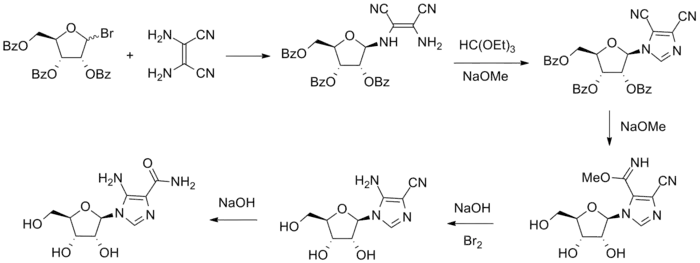 | |
| Clinical data | |
|---|---|
| ATC code | |
| Identifiers | |
| |
| CAS Number | |
| PubChem CID | |
| IUPHAR/BPS | |
| ChemSpider | |
| UNII | |
| KEGG | |
| ChEBI | |
| ChEMBL | |
| CompTox Dashboard (EPA) | |
| ECHA InfoCard | 100.018.271 |
| Chemical and physical data | |
| Formula | C9H14N4O5 |
| Molar mass | 258.234 g·mol−1 |
| 3D model (JSmol) | |
| |
| |
| | |
Acadesine (INN), also known as 5-aminoimidazole-4-carboxamide-1-β-D-ribofuranoside, AICA-riboside, and AICAR, is an AMP-activated protein kinase activator[1] which is used for the treatment of acute lymphoblastic leukemia[2] and may have applications in treating other disorders such as diabetes.[3] AICAR has been used clinically to treat and protect against cardiac ischemic injury.[4] The drug was first used in the 1980s as a method to preserve blood flow to the heart during surgery.[5]
Acadesine is an adenosine regulating agent developed by PeriCor Therapeutics and licensed to Schering-Plough in 2007 for phase III studies. The drug is a potential first-in-class agent for prevention of reperfusion injury in CABG surgery. Schering began patient enrollment in phase III studies in May 2009. The trial was terminated in late 2010 based on an interim futility analysis.[6]
Chemistry
Reaction of 2-bromo tribenzoyl ribose with diaminomaleonitrile results in the displacement of the anomeric halogen by one of the amino groups and the formation of the aminosugar largely as the β-anomer. Treatment of this product with methyl orthoformate in the presence of a base leads to the replacement of the alkoxy groups in orthoformate by the adjacent amines, resulting in the formation of the imidazole ring. Reaction with alkoxide then converts the nitrile nearest the sugar to an iminoester; the benzoyl groups are cleaved in the process. Hofmann rearrangement in the presence of a bromine and a base converts the iminoester to the corresponding primary amine. Basic hydrolysis then converts the remaining nitrile to an amide, affording acadesine.[7]

Medical use
A brief period of coronary arterial occlusion followed by reperfusion prior to prolonged ischemia is known as preconditioning. It has been shown that this is protective. Preconditioning preceded myocardial infarction, may delay cell death and allow for greater salvage of myocardium through reperfusion therapy.[8] AICAR has been shown to precondition the heart shortly before or during ischemia.[9] AICAR triggers a preconditioned anti-inflammatory state by increasing NO production from endothelial nitric oxide synthase.[10] When AICAR is given 24 hours prior to reperfusion, it prevents post ischemic leukocyte-endothelial cell adhesive interactions with increased NO production.[11] AICAR-dependent preconditioning is also mediated by an ATP-sensitive potassium channel and hemeoxygenase-dependent mechanism. It increases AMPK-dependent recruitment of ATP-sensitive K channels to the sarcolemma causing the action potential duration to shorten, and preventing calcium overload during reperfusion.[12] The decrease in calcium overload prevents inflammation activation by ROS.[13] AICAR also increases AMPK-dependent glucose uptake through translocation of GLUT-4 which is beneficial for the heart during post-ischemic reperfusion.[14] The increase in glucose during AICAR preconditioning lengthens the period for preconditioning up to 2 hours in rabbits and 40 minutes in humans undergoing coronary ligation.[8][15] As a result, AICAR reduces the frequency and size of myocardial infarcts up to 25% in humans allowing improved blood flow to the heart.[8][16] As well, the treatment has been shown to decrease the risk of an early death and improve recovery after surgery from an ischemic injury.[8]
Pharmacology and use in doping
Acadesine acts as an AMP-activated protein kinase agonist.[4] It stimulates glucose uptake and increases the activity of p38 mitogen-activated protein kinases α and β in skeletal muscle tissue,[17] as well as suppressing apoptosis by reducing production of reactive oxygen compounds inside the cell.[18]
In 2008, researchers at the Salk Institute discovered that acadesine injected in mice significantly improved their performance in endurance-type exercise, apparently by converting fast-twitch muscle fibers to the more energy-efficient, fat-burning, slow-twitch type. They also looked at the administration of GW 501516 (also called GW1516) in combination with acadesine. Given to mice that did not exercise, this combination activated 40% of the genes that were turned on when mice were given GW1516 and made to exercise. This result drew attention to the compound as a possible athletic endurance aid.[19] One of the lead researchers from this study has developed a urine test to detect it and has made the test available to the International Olympic Committee, and the World Anti-Doping Agency (WADA) has added acadesine to the prohibited list from 2009 onwards.[20] The British Medical Journal reported in 2009 that WADA had found evidence that acadesine was used by cyclists in the 2009 Tour de France.[21]
See also
References
- ↑ Favero CB, Mandell JW (September 2007). "A pharmacological activator of AMP-activated protein kinase (AMPK) induces astrocyte stellation". Brain Research. 1168: 1–10. doi:10.1016/j.brainres.2007.06.087. PMC 2000700. PMID 17706943.
- ↑ Cronstein BN, Kamen BA (December 2007). "5-aminoimidazole-4-carboxamide-1-beta-4-ribofuranoside (AICA-riboside) as a targeting agent for therapy of patients with acute lymphoblastic leukemia: are we there and are there pitfalls?". Journal of Pediatric Hematology/Oncology. 29 (12): 805–7. doi:10.1097/MPH.0b013e31815bbb83. PMID 18090925.
- ↑ Cuthbertson DJ, Babraj JA, Mustard KJ, Towler MC, Green KA, Wackerhage H, et al. (August 2007). "5-aminoimidazole-4-carboxamide 1-beta-D-ribofuranoside acutely stimulates skeletal muscle 2-deoxyglucose uptake in healthy men". Diabetes. 56 (8): 2078–84. doi:10.2337/db06-1716. PMID 17513706.
- 1 2 Corton JM, Gillespie JG, Hawley SA, Hardie DG (April 1995). "5-aminoimidazole-4-carboxamide ribonucleoside. A specific method for activating AMP-activated protein kinase in intact cells?". European Journal of Biochemistry. 229 (2): 558–65. doi:10.1111/j.1432-1033.1995.0558k.x. PMID 7744080.
- ↑ Galiñanes M, Bullough D, Mullane KM, Hearse DJ (August 1992). "Sustained protection by acadesine against ischemia- and reperfusion-induced injury. Studies in the transplanted rat heart". Circulation. 86 (2): 589–97. doi:10.1161/01.cir.86.2.589. PMID 1638724.
- ↑ "Research and Development Update". Merck & Co., Inc. 30 June 2010.
In the third quarter of 2010, the Company terminated the internal clinical development program for acadesine, an adenosine regulating agent for ischemia reperfusion injury in patients undergoing heart bypass surgery. Merck has decided to follow the recommendation of the independent Data Safety Monitoring Board ("DSMB") to stop enrollment of the RED-CABG trial based upon the DSMB's review of a pre-specified interim futility analysis which showed a low probability of the trial meeting its primary efficacy endpoint.
- ↑ Ferris JP, Devadas B, Huang CH, Ren WY (1985). "Nucleosides from carbohydrate adducts of diaminomaleonitrile. A novel synthesis of 5-amino-1-(.beta.-D-ribofuranosyl)imidazole-4-carboxamide and 5-amino-1-(.beta.-D-ribopyranosyl)imidazole-4-carboxamide". The Journal of Organic Chemistry. 50 (6): 747–754. doi:10.1021/jo00206a004.
- 1 2 3 4 Murry CE, Jennings RB, Reimer KA (November 1986). "Preconditioning with ischemia: a delay of lethal cell injury in ischemic myocardium". Circulation. 74 (5): 1124–36. doi:10.1161/01.cir.74.5.1124. PMID 3769170.
- ↑ Mullane K (January 1993). "Acadesine: the prototype adenosine regulating agent for reducing myocardial ischaemic injury". Cardiovascular Research. 27 (1): 43–7. doi:10.1093/cvr/27.1.43. PMID 8458030.
- ↑ Gaskin FS (2007). Mechanisms of adenosine monophosphate-activated protein kinase-induced preconditioning in ischemia/reperfusion (Report). University of Missouri-Columbia.
- ↑ Gaskin FS, Kamada K, Yusof M, Durante W, Gross G, Korthuis RJ (February 2009). "AICAR preconditioning prevents postischemic leukocyte rolling and adhesion: role of K(ATP) channels and heme oxygenase". Microcirculation. 16 (2): 167–76. doi:10.1080/10739680802355897. PMC 2784925. PMID 19152177.
- ↑ Sukhodub A, Jovanović S, Du Q, Budas G, Clelland AK, Shen M, Sakamoto K, Tian R, Jovanović A (January 2007). "AMP-activated protein kinase mediates preconditioning in cardiomyocytes by regulating activity and trafficking of sarcolemmal ATP-sensitive K(+) channels". Journal of Cellular Physiology. 210 (1): 224–36. doi:10.1002/jcp.20862. PMC 2128052. PMID 17044064.
- ↑ Tsuchida A, Yang XM, Burckhartt B, Mullane KM, Cohen MV, Downey JM (March 1994). "Acadesine extends the window of protection afforded by ischaemic preconditioning". Cardiovascular Research. 28 (3): 379–83. doi:10.1093/cvr/28.3.379. PMID 8174159.
- ↑ Russell RR, Bergeron R, Shulman GI, Young LH (August 1999). "Translocation of myocardial GLUT-4 and increased glucose uptake through activation of AMPK by AICAR". The American Journal of Physiology. 277 (2): H643–9. doi:10.1152/ajpheart.1999.277.2.H643. PMID 10444490.
- ↑ Burckhartt B, Yang XM, Tsuchida A, Mullane KM, Downey JM, Cohen MV (May 1995). "Acadesine extends the window of protection afforded by ischaemic preconditioning in conscious rabbits". Cardiovascular Research. 29 (5): 653–7. PMID 7606753.
- ↑ Mangano DT (1997). "Effects of acadesine on myocardial infarction, stroke, and death following surgery. A meta-analysis of the 5 international randomized trials. The Multicenter Study of Perioperative Ischemia (McSPI) Research Group". JAMA. 277 (4): 325–32. doi:10.1001/jama.277.4.325. PMID 9002496.
- ↑ Lemieux K, Konrad D, Klip A, Marette A (September 2003). "The AMP-activated protein kinase activator AICAR does not induce GLUT4 translocation to transverse tubules but stimulates glucose uptake and p38 mitogen-activated protein kinases alpha and beta in skeletal muscle". FASEB Journal. 17 (12): 1658–65. doi:10.1096/fj.02-1125com. PMID 12958172. S2CID 84040744.
- ↑ Kim JE, Kim YW, Lee IK, Kim JY, Kang YJ, Park SY (March 2008). "AMP-activated protein kinase activation by 5-aminoimidazole-4-carboxamide-1-beta-D-ribofuranoside (AICAR) inhibits palmitate-induced endothelial cell apoptosis through reactive oxygen species suppression". Journal of Pharmacological Sciences. 106 (3): 394–403. doi:10.1254/jphs.FP0071857. PMID 18360094.
- ↑ Narkar VA, Downes M, Yu RT, Embler E, Wang YX, Banayo E, et al. (August 2008). "AMPK and PPARdelta agonists are exercise mimetics". Cell. 134 (3): 405–15. doi:10.1016/j.cell.2008.06.051. PMC 2706130. PMID 18674809.
- ↑ WADA 2009 Prohibited List Archived 2009-02-03 at the Wayback Machine
- ↑ Benkimoun P (October 2009). "Police find range of drugs after trawling bins used by Tour de France cyclists". BMJ. 339: b4201. doi:10.1136/bmj.b4201. PMID 19825964. S2CID 45264608.